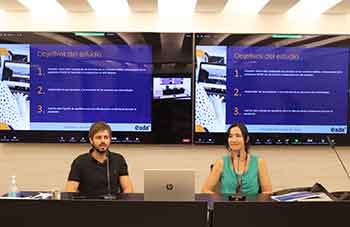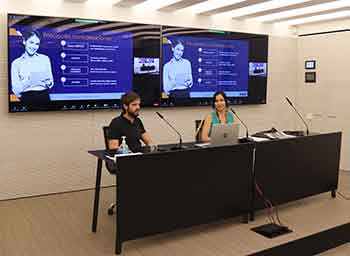Teleworking in times of Covid, one year on
 The forced teleworking that was implemented a year ago in organizations due to Covid-19 has become in 2021 a more flexible and planned formula. It is one of the main conclusions revealed by the Teleworking in Times of COVID, one year on report, led by EADA professor, Dr. Aline Masuda, in collaboration with EADA Alumni and researchers Luciano Strucchi and Edgar Quero.
The forced teleworking that was implemented a year ago in organizations due to Covid-19 has become in 2021 a more flexible and planned formula. It is one of the main conclusions revealed by the Teleworking in Times of COVID, one year on report, led by EADA professor, Dr. Aline Masuda, in collaboration with EADA Alumni and researchers Luciano Strucchi and Edgar Quero.
The study, which compares the data collected in May 2020 with that of this year, highlights that 68% of those surveyed make a positive assessment of the teleworking experience. Problems such as family interruptions, an inadequate work area, concern over the financial crisis or being able to connect are no longer major preoccupations. For example, according to the report, this year overtime work hours (more than 8 hours per day) have been reduced, from 46% in 2021 to 40% today, and work-life balance has been improved (separating personal time from professional) , going from 48% to 43%. In addition, the percentage of people who consider that they are more productive working at home has increased, from 41% in 2020 to 51% today.
However, the study shows several negatives. Above all, the greater sense of isolation and stress from working from home stands out. Specifically, 53% of those surveyed recognize that this year the relationship with their colleagues has seriously weakened (this percentage was only 16% in 2020). Furthermore, almost half of those surveyed (49%) express a feeling of isolation and 52% claim to have moderate or severe symptoms of burnout.
Keys to a more productive teleworking
 To face this situation, Dr. Aline Masuda proposes several solutions. “The first is for the company to allow employees to choose the modality that best suits their needs (face-to-face, remote or a hybrid format). Not everyone has the ability to self-manage and create their own schedules. In the same way, there are autonomous people who are happier and more productive with this formula, so they have to be provided with the tools and resources necessary to carry out their work .”
To face this situation, Dr. Aline Masuda proposes several solutions. “The first is for the company to allow employees to choose the modality that best suits their needs (face-to-face, remote or a hybrid format). Not everyone has the ability to self-manage and create their own schedules. In the same way, there are autonomous people who are happier and more productive with this formula, so they have to be provided with the tools and resources necessary to carry out their work .”
Secondly, the EADA professor emphasises the relevance that the figure of the leader has now more than ever, “since it must unite the team from the distance, resolve conflicts, maintain a constant dialogue with them, offer them social support, create spaces so that they interrelate and establish emotional ties.” And she adds: "Several reports indicate that stress and social support are related."
A third aspect that Masuda refers to is the need for employees to agree to telework regulation with the company. She refers, for example, to establishing specific hours and the resources that they will have, and that all this is in writing. In this sense, the EADA professor is committed, once again, to "work by objectives instead of by hours."
Professor Masuda is still in favour of combining telework with face-to-face work and maintains her recommendations when working from home:
- Establish a routine and work in blocks instead of continuously. It is advisable to have a break around lunchtime to do sport or other activities.
- Avoid an excess of video conferences as they can cause fatigue (a maximum of 2 meetings a day)
- Establish a timetable for receiving and replying to emails and WhatsApps
- Agree your work patterns with your team/supervisor
- Make time to transition between professional and family activities
